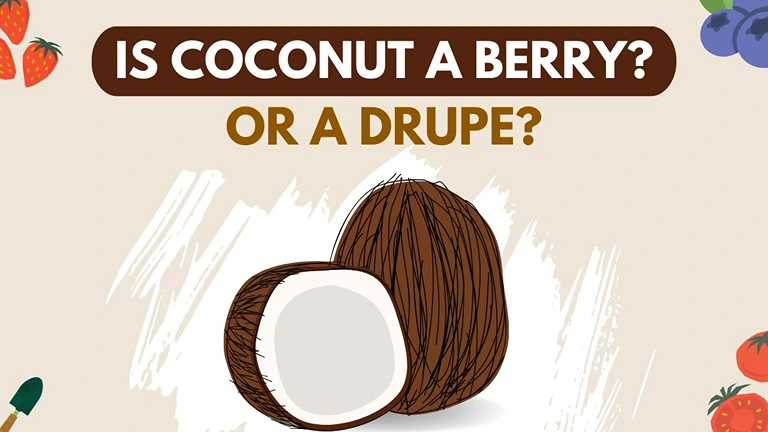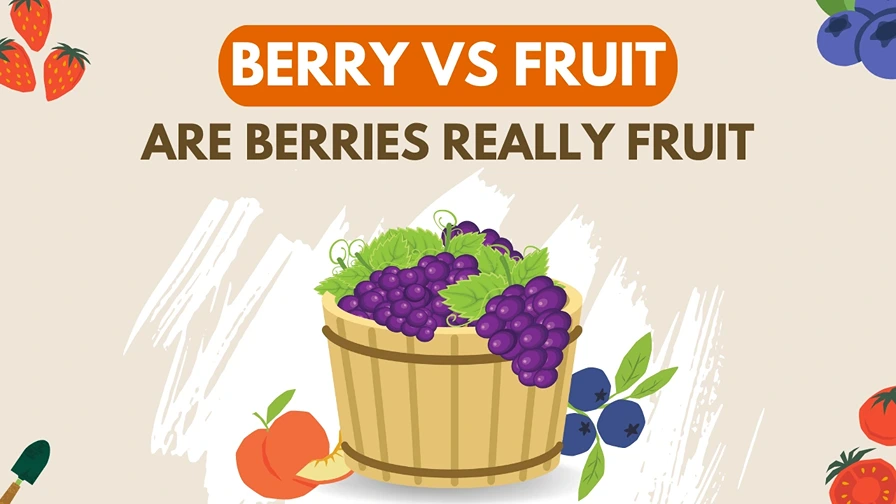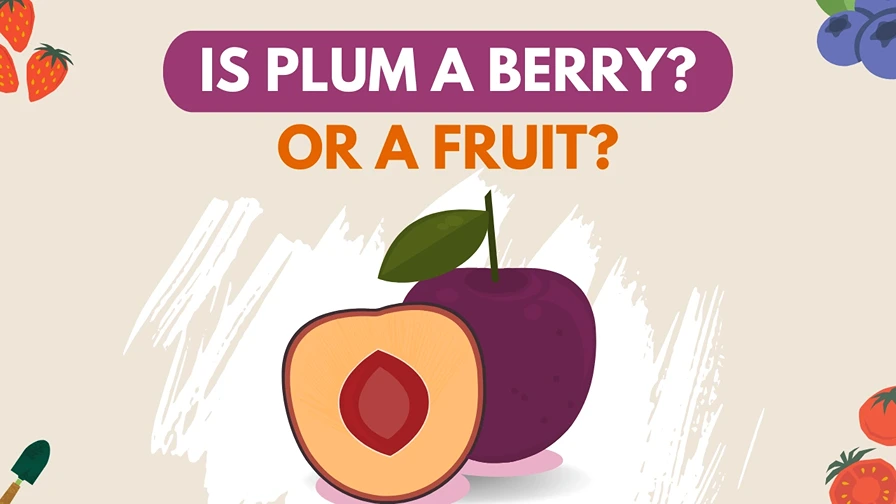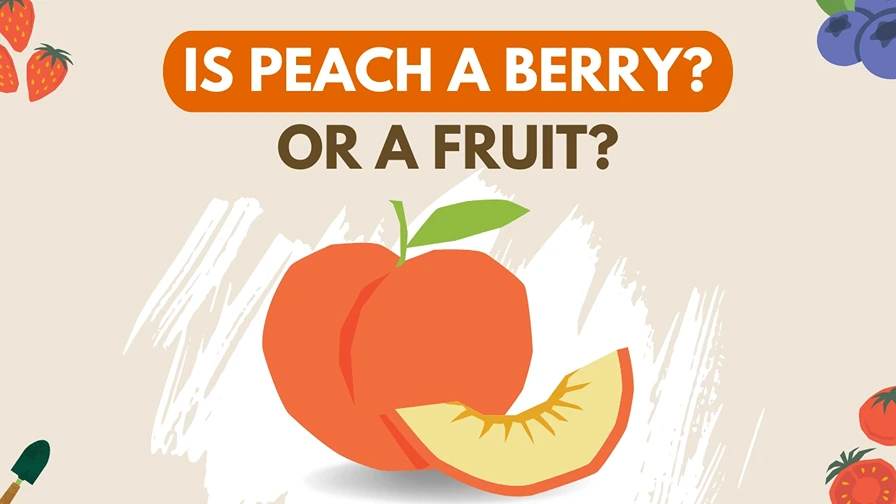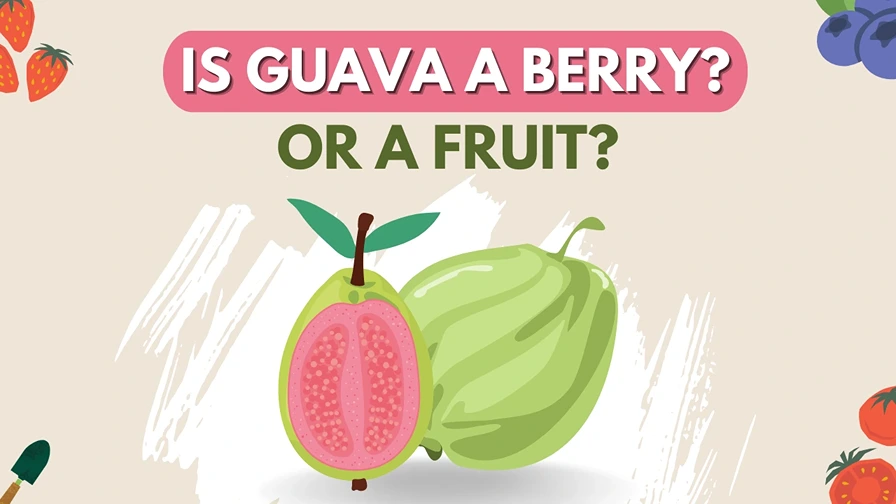You might have enjoyed sipping on refreshing coconut water or relished the creamy texture of coconut milk in your favorite curry. But have you ever wondered about the botanical classification of this tropical delight? Is coconut a berry?
To give a precise answer: Coconut is not a berry but a drupe fruit.
But why is coconut a drupe not classified as a berry?
Let’s explore the fascinating world of coconut taxonomy and uncover the truth behind this intriguing question and clearly about the debate of berry vs fruit debate.
What is a Berry?
Before we delve into the specific characteristics of berries, let’s clarify the botanical definitions used in the world of botany. Botany is the scientific study of plants, their structure, growth, reproduction, and classification. Categorizing plants into different groups based on shared characteristics is an essential aspect of this field.
Defining Botanical Berries
In botany, a berry is a type of fruit that develops from a single ovary. It is characterized by having a fleshy pericarp (fruit wall) that is soft throughout. Berries also contain one or more seeds, which are often embedded within the fruit’s flesh. Examples of botanical berries include tomatoes, grapes, and bananas
Characteristics of Botanical Berries
To better understand the distinguishing features of botanical berries, let’s explore their characteristics:
- Single Ovary Development: Botanical berries originate from a single ovary, which is the part of the flower that contains the female reproductive cells. After successful pollination and fertilization, the ovary undergoes further development to become the fruit.
- Soft and Fleshy Pericarp: A significant characteristic of botanical berries is their soft and fleshy pericarp, which refers to the entire fruit wall. Unlike other fruits with harder or tougher pericarps, such as apples or oranges, berries have a consistently soft and fleshy texture throughout.
- Embedded Seeds: Berries contain one or more seeds that are typically embedded within the fruit’s flesh. These seeds can vary in size and shape depending on the specific berry. Some berries, like strawberries, have numerous tiny seeds on the outer surface, while others, like blueberries, have several small seeds within the flesh.
Examples of Botanical Berries
Now that we have a clearer understanding of what constitutes a botanical berry, let’s explore some common examples:
- Tomatoes: Yes, you read it right! Tomatoes are actually considered botanical berries. They meet all the criteria: a fleshy pericarp, seeds embedded within the flesh, and development from a single ovary. While we often think of tomatoes as vegetables, they are, botanically speaking, berries.
- Grapes: Grapes are another excellent example of botanical berries. They possess thin skin, juicy flesh, and contain multiple seeds. The entire pericarp of a grape is soft and fleshy, making it a true botanical berry.
- Bananas: Though they may not look like traditional berries, bananas are classified as botanical berries. They have a soft and fleshy pericarp, contain seeds (which are often reduced to tiny specks), and develop from a single ovary.
In summary, berries are fruits that develop from a single ovary, have a soft and fleshy pericarp throughout, and contain one or more seeds. Examples of botanical berries include tomatoes, grapes, and bananas.
What is a Coconut?
Coconuts are fascinating fruits that have long been associated with tropical regions and exotic flavors. Coconuts are renowned for their versatility, as every part of the fruit has various uses.
Coconuts are large, oval-shaped fruits that grow on the coconut palm tree, scientifically known as Cocos nucifera. These trees thrive in tropical and subtropical regions, where they have been cultivated for thousands of years.
History and Origin of Coconut
The history and origin of the coconut palm tree and its fruit are deeply rooted in the tropical regions of the world.
The Ancient Roots
- Tropical Origins: The coconut palm tree, scientifically known as Cocos nucifera, is believed to have originated in the tropical regions of Southeast Asia, specifically in the Indo-Malaysian region. The exact location of its origin remains a subject of debate among researchers. However, it is widely accepted that coconuts have been present in these regions for thousands of years.
- Coastal Adaptation: Coconut palm trees have a remarkable ability to adapt to coastal environments. Their tolerance for sandy soil, high salinity, and exposure to ocean winds enabled them to thrive in coastal areas. This adaptation played a crucial role in the dispersal and spread of coconuts across different parts of the world.
Cultural Significance and Dispersal
- The Tree of Life: Coconuts have held immense cultural significance and have been referred to as the “Tree of Life” in many tropical societies. The coconut palm has provided abundant resources and sustenance to the communities living in these regions for centuries.
- Maritime Trade and Dispersal: The dispersal of coconuts to various parts of the world can be attributed to ancient maritime trade routes and human activities. As early as the 5th century BCE, seafaring communities began to carry coconuts during their voyages, allowing the fruit to reach distant lands. Coconuts found their way to East Africa, the Indian subcontinent, and the Pacific Islands, and even as far as South America.
- Natural Dispersal: In addition to human-mediated dispersal, coconuts also possess natural mechanisms for propagation. The buoyant nature of the fruit and the ability of coconuts to withstand saltwater helped them spread along coastlines, carried by ocean currents. This natural dispersal further contributed to the wide distribution of coconuts in tropical regions.
Cultivation and Expansion
- Human Cultivation: The cultivation of coconuts began early in human history. Communities recognized the value of coconut trees and actively planted them for their various benefits. The knowledge of coconut cultivation and horticultural practices associated with the palm tree was passed down through generations.
- Global Expansion: The arrival of European explorers in the tropics during the Age of Discovery further expanded the distribution of coconuts. The explorers encountered coconuts during their voyages and introduced them to new territories, including the Caribbean, Central America, and West Africa. Coconuts became established in these regions and became integral to the local cultures and economies.
The history and origin of coconuts are deeply intertwined with the tropical regions of the world. With its tropical origins, cultural significance, maritime trade routes, and natural dispersal mechanisms, the coconut palm tree and its fruit have spread across the globe, becoming a vital part of numerous societies and ecosystems.
Botanical Classification of Coconut
We now know what is a berry. Let’s discuss the botanical classification of coconuts to compare them with the classification of berries and find out if coconuts are also berries or not.
- Taxonomic Classification: Coconuts belong to the plant family Arecaceae, commonly known as the palm family. Within this family, coconuts are classified under the genus Cocos and the species Nucifera. The scientific name for the coconut palm tree is thus Cocos nucifera.
- Monocot Angiosperm: Coconut palms are classified as monocots, which are a type of flowering plant characterized by having a single embryonic cotyledon (seed leaf) within their seeds. Other examples of monocots include grasses, lilies, and orchids.
- Order and Family: Coconut palms belong to the order Arecales, which includes other palm tree species. The order Arecales falls under the class Magnoliopsida, also known as the dicotyledons or dicots. However, despite being classified under dicots, coconuts are, in fact, monocots due to their specific characteristics.
Characteristics of Coconut
The coconut palm tree and its fruit possess distinctive features that contribute to their botanical classification.
- Coconut Fruit: The fruit has a hard endocarp that encloses a single seed, which is the coconut “meat” or flesh. The hard endocarp protects the seed, and its presence is a defining characteristic of drupes. We will discuss the fruit in detail later.
- Palmate Leaves: The leaves of the coconut palm are palmate, meaning they are divided into multiple leaflets that radiate from a central point. This palmate arrangement gives the leaves their characteristic fan-like appearance.
- Tall and Stately Growth: Coconut palms are known for their tall and stately growth habit. They can reach heights of up to 30 meters (98 feet) or more, with a slender trunk that is ringed with scars of fallen leaves.
- Adaptation to Coastal Environments: Coconut palms have adapted to thrive in coastal environments, particularly in tropical regions. They can tolerate sandy soils, high salinity, and exposure to ocean winds. This adaptation has allowed them to flourish along coastlines and on islands worldwide.
The botanical classification of coconuts places them in the plant family Arecaceae, genus Cocos, and species Nucifera. They are classified as drupe fruits, belonging to the order Arecales within the class Magnoliopsida. Their monocot nature is characterized by having a single embryonic cotyledon.
The unique features of coconuts, such as their palmate leaves, tall growth habit, and adaptation to coastal environments, contribute to their distinct botanical identity.
The Anatomy of Coconut Fruit
To better understand coconuts, let’s explore their anatomy and the different parts that make up this intriguing fruit.
- Exocarp (Husk): The outermost layer of coconut is called the exocarp, commonly known as the husk. The husk is composed of tough, fibrous material that provides protection to the inner layers of the fruit. It is often brown in color and may have a hairy or woody texture.
- Mesocarp: Beneath the husk lies the mesocarp, which is a thick, fibrous layer. This layer surrounds the actual seed of the coconut and plays a crucial role in protecting it during development. The mesocarp contributes to the characteristic appearance and texture of the mature coconut.
- Endocarp (Shell): The endocarp, also referred to as the shell, is the hard and woody inner layer of the coconut. It encloses the seed and provides exceptional durability and protection. The endocarp is responsible for giving coconuts their iconic toughness and resistance.
- Coconut “Meat” (Flesh): Inside the hard endocarp, we find the edible part of the coconut, commonly known as the “meat” or flesh. The coconut meat is white in color and has a rich, creamy texture. It is highly nutritious and is widely used in culinary applications, such as curries, desserts, and smoothies.
- Coconut Water: Within the hollow space of a mature coconut lies the coconut water. Coconut water is a clear liquid that has a sweet and refreshing taste. It is often enjoyed as a standalone beverage and is known for its hydrating properties. Coconut water is also used as an ingredient in various recipes and as a base for tropical drinks.
Is Coconut a Berry?
The question of whether a coconut can be classified as a berry has intrigued many.
We have discussed the classification of berries above so let’s summarize the definition of berries and then compare that with the classification of coconut fruit.
Defining Botanical Berries
Botanically speaking, a berry is a type of fruit that develops from a single ovary and has a fleshy pericarp (fruit wall) that is soft throughout. Berries also typically contain one or more seeds embedded within the flesh.
Evaluating Coconut Characteristics
Now let’s examine the specific characteristics of coconuts and compare them to the criteria for botanical berries.
- Single Ovary Development: While coconuts do develop from a single ovary, like berries, this alone does not determine their classification. Further examination is needed to consider other aspects.
- Soft and Fleshy Pericarp: One of the distinguishing features of botanical berries is a soft and fleshy pericarp throughout the fruit. However, when we analyze the anatomy of a coconut, we find that its pericarp does not meet this criterion. The coconut’s husk (exocarp) and the fibrous layer beneath (mesocarp) are not soft and fleshy; they are tough and fibrous in nature.
- Seeds within the Flesh: Another characteristic of botanical berries is the presence of one or more seeds embedded within the fruit’s flesh. Coconuts do contain seeds, commonly referred to as the coconut “meat,” but they are not embedded within the flesh. Instead, the meat is distinct from the fibrous layers of the coconut.
So by examining the classification of berries and coconut together, we can accurately say that. Coconuts are not classified as berries.
So what are coconuts classified as? Let’s explore what coconut is actually classified as in the botanical realm.
Is Coconut a Drupe?
When considering the botanical classification of coconuts, the term “drupe” often arises. In this section, we will delve into the characteristics of coconuts and examine whether they can be classified as drupes.
Understanding Drupe Fruits
To determine whether coconuts are drupes, it is important to understand the defining features and characteristics of this fruit category.
A drupe fruit, also known as stone fruit, is a type of fruit that has fleshy fruit that typically contains a single seed encased within a hard, stony endocarp (inner layer) and surrounded by a fleshy mesocarp (middle layer) and an outer exocarp (outer layer).
Characteristics of a Drupe Fruit:
- Single Seed: Drupe fruits typically have a single seed within them. This distinguishes them from fruits with multiple seeds, such as berries.
- Hard Endocarp: The seed of a drupe fruit is protected by a hard, stony endocarp. This provides structural support and shields the seed from external elements.
- Fleshy Mesocarp: Surrounding the seed is a fleshy mesocarp, which is soft and often juicy. The mesocarp is the edible part of the fruit that we enjoy consuming.
- Outer Exocarp: The outermost layer of a drupe fruit is the exocarp, which can vary in texture and thickness depending on the specific fruit. The exocarp can be smooth, fuzzy, or even leathery, depending on the fruit variety.
- Diverse Examples: Some common examples of drupe fruits include peaches, plums, cherries, apricots, and olives. These fruits share the characteristic features of a single seed encased within a hard endocarp and a fleshy mesocarp.
Is Coconut a Drupe Or Not?
Let’s examine the specific characteristics of coconuts and compare them to the criteria for drupe fruits.
- Hard Endocarp (The Shell): Coconuts possess a hard and stony endocarp, which is commonly referred to as the shell. This shell surrounds the seed (coconut “meat”) and provides exceptional durability and protection. The hard endocarp of coconuts aligns with the defining characteristic of drupe fruits.
- Single Seed (The Coconut “Meat”): Within the coconut, we find a single seed known as the coconut “meat” or flesh. This seed is encased within the hard endocarp, fulfilling another requirement for drupe classification. The presence of a single seed distinguishes drupes from fruits with multiple seeds.
- Mesocarp and Exocarp: While coconuts do possess a mesocarp (fibrous layer) and an exocarp (husk), it is the hard endocarp and the seed that are particularly relevant in determining their classification. The fibrous layers are external to the essential characteristics that define coconuts as drupes.
Considering the presence of a hard endocarp encasing a single seed, coconuts fit the criteria for classification as drupe fruits.
Versatility and Uses of Coconuts
Coconuts are renowned for their remarkable versatility, as every part of the fruit finds practical applications. Here are some common uses of coconuts:
- Culinary Delights: The coconut flesh is widely used in cooking, both in savory and sweet dishes. It adds a unique flavor and texture to curries, desserts, baked goods, and beverages.
- Coconut Oil: The meat of the coconut can be pressed to extract coconut oil, which is used for cooking, skincare, and haircare purposes. Coconut oil is highly valued for its natural moisturizing and nourishing properties.
- Coconut Milk: By blending the grated flesh of a coconut with water, you can obtain creamy coconut milk. This milk is commonly used in various cuisines, particularly in Southeast Asian and Caribbean cooking.
- Coconut Water: The clear liquid inside a young, green coconut is known as coconut water. It is a popular beverage that is refreshing and hydrating, often enjoyed on its own or used as a base for smoothies and cocktails.
- Fiber and Crafts: The husk of the coconut provides fiber that can be used for making ropes, mats, brushes, and other crafts. This versatile material has been utilized in various traditional industries.
Conclusion
In conclusion, the question of whether a coconut can be classified as a berry or not has become very clear. The coconuts do not meet the botanical criteria to be considered berries. Instead, they are more accurately classified as drupe fruits.
The characteristics of coconuts, such as the tough and fibrous pericarp, the separation of the seed (coconut “meat”) from the flesh, and the presence of a hard endocarp, align with the botanical definition of drupes. These features distinguish coconuts from botanical berries, which have soft and fleshy pericarp, embedded seeds, and a different structural composition.
So, while a coconut may not be a botanical berry, its classification as a drupe highlights its distinct characteristics and reinforces its importance in tropical ecosystems and the lives of people worldwide.

